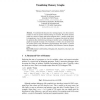Free Online Productivity Tools
i2Speak
i2Symbol
i2OCR
iTex2Img
iWeb2Print
iWeb2Shot
i2Type
iPdf2Split
iPdf2Merge
i2Bopomofo
i2Arabic
i2Style
i2Image
i2PDF
iLatex2Rtf
Sci2ools
DAGSTUHL
2001
2001
Visualizing Memory Graphs
To understand the dynamics of a running program, it is often useful to examine its state at specific moments during its execution. We present memory graphs as a means to capture and explore program states. A memory graph gives a comprehensive view of all data structures of a program; data items are related by operations like dereferencing, indexing or member access. Although memory graphs are typically too large to be visualized as a whole, one can easily focus on specific aspects using well-known graph operations. For instance, a greatest common subgraph visualizes commonalities and differences between program states.
| Added | 31 Oct 2010 |
| Updated | 31 Oct 2010 |
| Type | Conference |
| Year | 2001 |
| Where | DAGSTUHL |
| Authors | Thomas Zimmermann, Andreas Zeller |
Comments (0)

